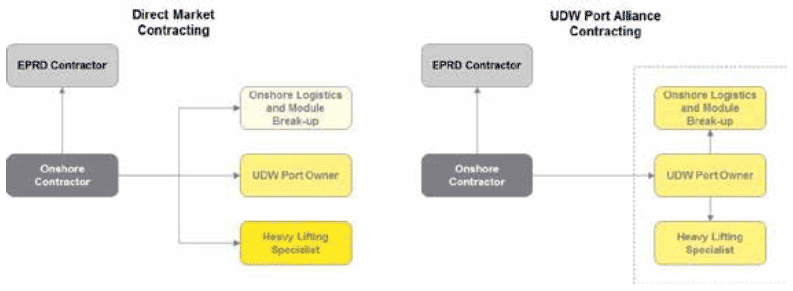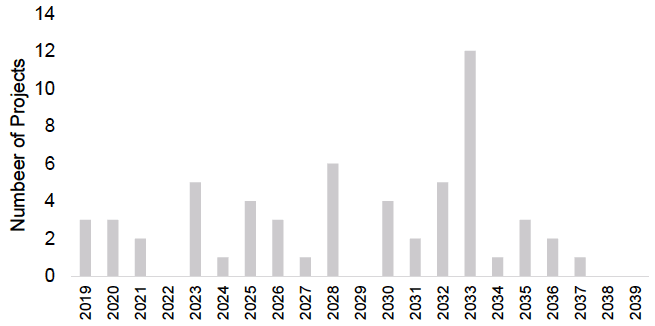Ultra-deep water port: feasibility study
Report compiled by Ernst & Young following their feasibility study looking at the most cost effective locations for an ultra-deep water port in the UK.
10. Transfer Hub
The level of economic benefit generated from an UDW port depends on its ability to attract projects. One approach which may support a higher number of projects to the UK is through the UDW port operating as a 'transfer hub'. If the UDW port could receive and quickly distribute modules to other sites this could free up capacity at the UDW port and create further activity at other locations. How this could operate, the potential commercial arrangements and the peak times of market demand are reviewed in this section.
10.1.1 Operational Assessment
At a high level, the following steps outline how a transfer hub could operate:
1. An UHLV will remove modules from the platform and transfer them to the UDW port. Once it has reached the port, modules will be transferred from the UHLV to the port laydown area.
2. Modules will either be broken down into smaller pieces or left as they are depending on the size requirements for onward transportation.
3. Broken down modules or whole modules are transferred to another yard for disposal and recycling activity.
The technical specifics within each of these steps should be considered in more detail as part of a subsequent technical review. This should include an assessment on the capital equipment needs at the UDW port, how the transfer of modules could operate in the most efficient and safe manner and what impact this may have on project costs.
10.1.2 Commercial Arrangements
The appropriate commercial model employed at a transfer hub would need to be tested with key market operators to ensure it is attractive for them. Two potential options - Direct Market Contracting and UDW Port Alliance Contracting - are outlined in the figure below.
Figure 6: Transfer Hub Commercial Models

Source: EY Analysis
Key roles in the process are:
- EPRD Contractor: Expected to be the UHLV operators as per the current industry norm.
- Onshore Contractor: The onshore contractor from the disposal yard which will perform the onshore decommissioning work.
- Onshore Logistics and Module Break-up: A contractor will be required to operate at the UDW port to support the receipt of modules and break them down into smaller pieces for transfer to the final port destination.
- UDW Port Owner: Provider of the UDW port used as the transfer hub.
- Heavy Lifting Specialist: Businesses specialising in heavy lifting who can transport modules from the UDW port to the onshore disposal yard.
In outlining potential commercial arrangements for a transfer hub, we have considered the need for the facility to be open for all onshore contractors to bid through. Our working assumption is that the onshore contractor is not tied to any port and would bid directly to the EPRD contractor.
Under the Direct Market Contracting, the onshore contractor will engage with these market participants separately and agree costs, apportionment of risks and scope of works with each contractor individually.
In the UDW Port Alliance Contracting, it is assumed that the UDW port has an alliance or series of alliances in place for the required services. This means that the onshore contractor would only be required to have one contract with the UDW port owner. This will places more risk and responsibility with the UDW port owner. However, if a standardised process is established, this may be attractive for the onshore contractor, who would not need to contract with multiple different businesses and be able to show the EPRD they are using a tried and tested process.
10.1.3 Market Assessment
The benefits of operating as a transfer hub will likely be realised when there is a significant demand for an UDW port. The figure below highlights the forecast timeline of decommissioning projects.
Figure 7: Forecast of Decommissioning Projects

Source: EY Analysis
There is a clear peak projects coming to market in 2030 to 2033. During this period, there could be a capacity constraint at existing facilities which would mean that having an UDW port that can operate as a transfer hub could help attract as many of these projects as possible.
Between 2023 and 2028, the forecasts highlight 20 projects coming to market. Again, operating as a transfer hub may help the UK attract as many of these projects as possible.
10.1.4 Risks
Key risks associated with developing the transfer hub are highlighted in the table below. This is supported by proposed mitigating actions. Further development of the project should consider these risks in more detail and have an agreed plan of how they can be managed and mitigated.
Table 31: Transfer Hub Key Risks
| Risk Type |
Description |
Mitigating Action |
|---|---|---|
| Price Risk |
With a transfer hub, there is a requirement for multiple modules to be moved from one onshore location to another. This has the potential to increase the overall costs of the decommissioning process. |
A detailed technical assessment is required to outline how this process could operate to ensure that the price charged for decommissioning via a transfer hub is competitive with direct to shore options. |
| Funding Risk |
The funding for an UDW port is still to be determined. Potential funders may include an onshore disposal contractor who we expected would require exclusive use of the facility for future projects. |
Further work is required to test the market and assess how the UDW port would be funded. |
| Demand Risk |
It is unclear on the demand for a transfer hub and how this option would be viewed by operators who may prefer that platform inventory is handled and managed as little as possible. |
Further work required to test the market and assess whether they would have a demand for this type of facility. |
| Economic Leakage |
As a transfer hub, there may be potential for onshore disposal work to be performed in locations outside the UK resulting in leakage of economic activity from the UK. |
To be reviewed and discussed with project stakeholders at a business case development stage. |
Source: EY Analysis
10.1.5 Summary
As a concept, the transfer hub has potential to be an attractive option if it is able to increase the capacity of the onshore decommissioning work which may be attracted to the UK and provide further benefit and income to other UK locations.
However, there are a number of key risks of such an operation with a key factor being potential leakage of work from the UK. A technical assessment of how such a facility could operate along with a review of impact on prices and key risks should be addressed as part of the Business Planning phase.
Contact
Email: Claire Stanley
There is a problem
Thanks for your feedback